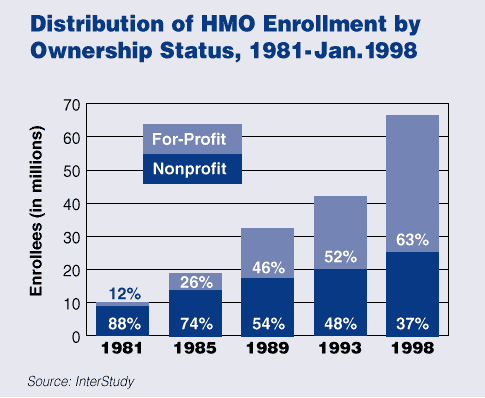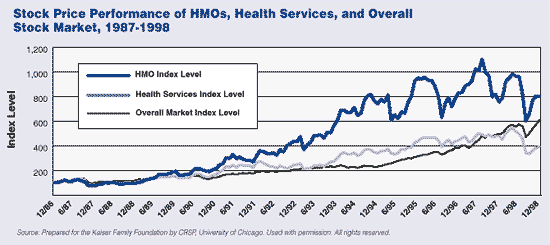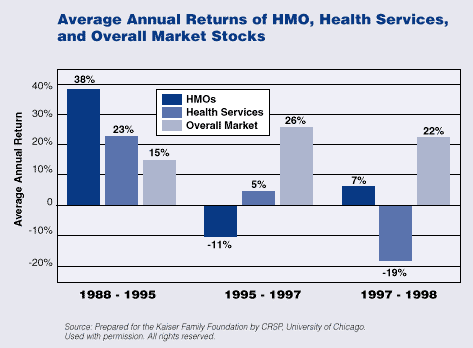MarketFacts: A Financial Overview of the Managed Care Industry – Fact Sheet
A Financial Overview of the Managed Care Industry
March 1999
Part 1
The rapid growth of managed care has brought with it a growing connection between the stock market andhealth care organizations. Health care services have evolved from being delivered by physicians and tax-exempt institutions to a market-driven industry attracting investment capital from numerous sources. The market capitalization, or total stock value, of the relatively young HMO industry grew from a little over $3 billion in 1987 to almost $39 billion in 1997 an almost twelve-fold increase while the stock mar-ket as a whole grew about four-fold to a total of $10.5 trillion. However, recent health plan earnings and premium announcements indicating companies difficulties in managing medical costs have led some equity analysts and investors to question whether these health sector stocks will offer growth potential in the future. And, financial difficulties in the HMO industry may have important implications for health policy debates that are increasingly connected to the practices and potential of private health plans.
The Growing Influence of For-Profit Organizations
The increased corporate influence in health care is espe-cially evident in the growing prevalence of for-profit companies within the HMO sector. Between 1981 and January 1998, for-profit HMOs grew from representing 12% to 63% of total HMO enrollees, and from 18% to 74% of plans (InterStudy). Among hospitals, on the other hand, for-profit companies have increased their role, but nonprofit organizations continue to dominate the industry. Between 1980 and 1996, for-profit companiesgrew from representing 9% to 13% of community hospi-tal beds (American Hospital Association).
The growing role of for-profit companies in the HMO and hospital sectors has resulted from a combination of the emergence and growth of for-profit companies, as well as conversion of not-for-profit companies to for-profit status. One outcome of these conversions is the estab-lishmentof charitable foundations designed to preserve the charitable missions and assets of the formerly not-for-profit organizations. As of February 1999, there were at least 109 conversion foundations in the U.S., with assets totaling about $13 billion. Health plan con-versions represented the source of only 11 of the founda-tions, but these foundations hold almost half of the total assets (Grantmakers in Health).


Stock Trends
Many for-profit health care compa-nies have tapped the stock marketfor financing. According to an analysis prepared for the KaiserFamily Foundation by Securities Data Company, there were 233 ini-tialpublic offerings (IPOs) of stock of health companies between 1987 and 1997.
The total stock value (or market cap-italization) of publicly traded healthservices and HMO companies has increased dramatically over the pastdecade. Total market capitalization of HMOs grew from $3.3 billion inJanuary 1987 to $38.9 billion as of the end of November 1997, an almost twelve-foldincrease. For companies classifying themselves as health services (including hospitals and nursing homes), capital-ization grew from $16.3 billion to $112.7 billion over thesame time frame. In comparison, the overall stock market grew a little over four-fold during this time period. Wall Street’s growing interest and role in health care companiesis also evidenced by the increased number of investment analysts following health care stocks from 152 in 1987 to 559 in 1997, according to Nelson’s Directory of Investment Research.

Over the last decade, HMO stocks generally out-per-formed the market as a whole, although they experienced periods of significant price declines, most recently betweenJuly and September 1998. In contrast, health services companies tracked just somewhat above the marketthrough much of the decade until 1998, when health ser-vices fell below the market. Recently, average annual returns for health services and HMO companies have suf-fered relative to the overall market. Using a University of Chicago index developed for the Kaiser Family Foundationthat measures the market-weighted return of stocks, a 1987 investment of $100 in the market as a whole would have grown to $610 by the end of 1998. In comparison, an investment of $100 in HMOs would have grown to $807, while a similar investment in helath services compa-nies would have increased to only $393. In 1998, HMOs performed a bit better than in the previous couple of years with average stock prices rising 7% over the course of the year compared to a drop of 11% from 1995 to 1997 but health services companies did quite a bit worse in 1998 and saw stock values fall by 19%. Many anticipate that slow recovery will continue for HMOs in 1999, but not to historic levels of stock price growth.
This Fact Sheet is also available in PDF format.Return to top
A Financial Overview of the Managed Care Industry
Fact Sheet Part 1 Fact Sheet Part 2
